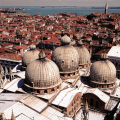BASILICA DI SAN MARCO
Majestic basilica with 5 domes, here is the most beautiful example of architectural syncretism between Eastern and Western styles.
St. Mark's Basilica is a unique blend of styles that relays the traditions of antiquity better than any other European building, via a strong Byzantine influence. In 828, Venice had the relic of the body of Saint Mark, but no church worthy of receiving it. This is why the first church of Saint Mark was built and consecrated in 832. It was destroyed in 976 in the fire that ravaged the ducal palace. A second one was consecrated in 978. Private chapel of the doges until 1797, it is only since 1807 cathedral of the city.
The exterior. The basilica was built on the model of the Church of the Holy Apostles in Constantinople, according to a Greek cross plan. In the following centuries, as the power and wealth of Venice increased, the building was considerably altered. Its present appearance dates from the late 15th and early 16th centuries. The sack of Constantinople in 1453 must have been the cause of the first phase of decoration. The basilica was graced with new domes (each of the lower domes was covered with a second, much higher, wooden-framed, lead-coated dome topped with a lantern and a golden cross). The upper arcades were modified between the end of the 14th century and the middle of the 15th century, crowned with Gothic sculptures that form a jagged frieze. The main façade is divided into 5 portals surmounted by 5 large arches. The central portal is closed by bronze doors brought from Byzantium in the 11th century. A porphyry rhombus marks the spot where Emperor Frederick Barbarossa was forced to kneel before Pope Alexander III in 1177. The inventory continues on the Loggia dei Cavalli, the belvedere above the central portal. It is here that the replicas of a famous quadriga dating from antiquity, the one featuring the copper horses stolen during the sack of Constantinople, are displayed. The portal opens onto the narthex, a transverse vestibule covered with marble and mosaics. Note on the south facade, which is at the corner with the ducal palace, the famous Tetrarchs (4th century) in red porphyry, governing the Roman Empire in 293. Legend has it that they were petrified Saracens for trying to steal the relics of Saint Mark...
The interior. Inside, unique mosaics cover a surface of about 4 000m2. This explosion of gold and color begins in the narthex where the decoration displays scenes borrowed from the first two books of the Old Testament, Genesis and Exodus. On the first dome of the narthex, to the right of the main entrance, one can see the Creation. On the central vault, the Flood, Noah's Ark and the Tower of Babel. The story of Abraham is represented on the dome to the left of the main entrance and, finally, the last dome tells the story of Moses. Once past the vestibule, one is struck by the beauty of the two central domes whose mosaics represent Pentecost (12th century) and the Ascension (13th century). The masterpiece is undoubtedly the one preserved behind the high altar, the Pala d'Oro. Also noteworthy is the door to the sacristy, decorated with bronze panels by Sansovino, on which his portrait and those of Titian and Aretinus can be seen. In the south wing is kept the treasure of St. Mark, consisting of masterpieces of Byzantine silverware also from the sack of Constantinople. Several pieces were lost, stolen or melted down in 1797 when Napoleon took over Venice. Finally, the pavement in marble and mosaics of the twelfth century, where alternate animal figures and geometric patterns, is also quite remarkable.
Pala d'Oro and Treasure (behind the main altar, respectively 2 and 3 €). Gold and more gold! You can see with your own eyes how rich and pious the Repubblica Serenissima was. The Treasure of San Marco is composed of religious objects such as chalices, incense burners and reliquaries (so far so good) but also extraordinary relics among which a lock of hair of the Virgin Mary, a real piece of wood from the cross of Christ and a vial of Christ's blood... As for the Pala d'Oro, this golden altarpiece measuring 1.40 m by 3.48 m, a unique masterpiece of Byzantine and Venetian jewelry, it is made up of 250 gold plates inlaid with pearls, themselves cloisonné with 80 enamels and set with some 3,000 precious and semi-precious stones. Made in 978 by goldsmiths from Constantinople for Doge Pietro Orseolo, then enlarged in the 12th and 13th centuries, it was completed in Gothic style by a Sienese goldsmith in 1345.
Museo Marciano (access from the staircase to the right of the basilica's entrance portal; €5). A must-see for a close-up view of the famous Horses of St. Mark. These four ancient statues in cast copper first adorned the hippodrome of Constantinople before being removed in 1204 by the Venetians to be placed above the main door of St. Mark's Basilica. In 1797, Bonaparte, general-in-chief of the Italian army, brought them to France. As emperor, he placed them on the triumphal arch of the Carrousel, a monument to the glory of his armies. Returned to Venice in 1815, they returned to the facade of the basilica. Replaced since 1980 by replicas, they are now in the museum, to be preserved from pollution.
Did you know? This review was written by our professional authors.
Members' reviews on BASILICA DI SAN MARCO
The ratings and reviews below reflect the subjective opinions of members and not the opinion of The Little Witty.

















Avant de faire la visite si vous avez un sac à dos vous devrez le déposer un peu plus loin en consigne car la visite n'est pas possible avec, la file d'attente est assez longue mais ça va assez viite
la visite est merveilleuse et prend bien une heure certaines parties sont payantes mais n'hesitez pas à les faire